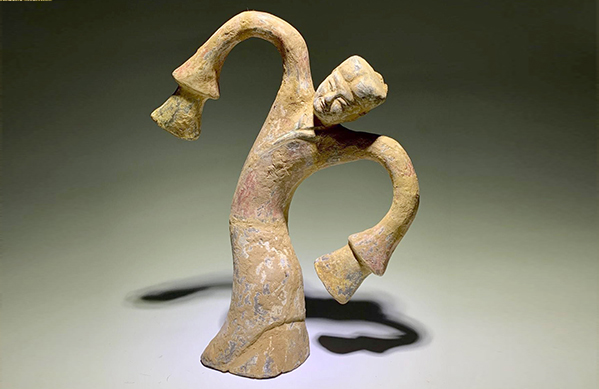Unearthing the Han Dynasty from northern Jiangsu

A Han-Dynasty terracotta dancer unearthed from Northern Jiangsu Province. Photo: FILE
Northern Jiangsu Province (usually abbreviated to Subei), is an area steeped in a glorious past. Having not only witnessed the birth of Han, it is also one of the most important areas where the Chu culture developed.
Remains of ancient city
After he established the Western Han Dynasty (206 BCE–8 CE), Liu Bang granted Xuzhou and its surrounding areas first to general Han Xin, and then to his brother Liu Jiao, as the Kingdom of Chu. Since then, the Chu Kingdom of the Han Dynasty centered in Xuzhou had been established. Xuzhou experienced a time of political, cultural, and economic prosperity during the Han Dynasty, evidenced by the remains of many ancient cities.
Pengcheng is located in the old town of Xuzhou, serving as the capital city of the Chu Kingdom during the Western Han Dynasty and of the Pengcheng Kingdom during the Eastern Han Dynasty (25–220). Later the city was submerged in silt due to frequent floods. In recent years, archaeologists indentified the location and structure of the eastern city wall of the ancient Pengcheng, and found a large number of Wuzhu Coins (a type of Chinese coin first produced during the Han Dynasty), Han Dynasty bricks and other ancient architectural materials from the city ruins. A rammed foundation of approximately 4,000 square meters was speculated to be the foundation of Chu Kingdom (Pengcheng Kingdom) palace.
Three Treasures of the Han Dynasty
The Han Dynasty tombs, stone reliefs, and terracotta warriors are significant cultural relics unearthed from the Subei area, reflecting the characteristics of both the Han and Chu cultures. They are praised as the Three Treasures of the Han Dynasty.
During the Han era, Xuzhou witnessed 18 kings successively. Their tombs are scattered around the city, composing the largest tomb complex of the Han-Dynasty kings. Among these tombs, the one located in Shizishan (Lion Hill) is the largest and most valuable, with the most unearthed cultural relics.
Chiseled over 20 meters deep into the rock, the grand tomb of a Chu king in Shizishan is 117 meters long from north to south, and 13.2 meters long from east to west. It was built as a replica of palace buildings, and consists of 12 burial chambers, including a bathroom, yufuku (an imperial storeroom for texts, documents and other treasures), yubingku (an imperial arsenal), a music room and the burial rooms of the king's wife and concubines. The tomb is a vivid depiction of the king of Chu's luxurious lifestyle, offering a remarkable glimpse into the popular Han Dynasty belief that the dead should be served in death as they would have been served in life. Over 2,000 pieces of precious artifacts were excavated from this tomb, including a jinlüyuyi, which is a jade suit sewn with gold thread (a funerary garment which completely encased the body of deceased royalty, made from hundreds of small rectangles of jade stitched together using gold wire), and a lacquered wood coffin inlaid with jade.
Another remarkable discovery from the Subei area Han Dynasty tombs, were the stone reliefs unearthed from a Han tomb in Maocun Town, Xuzhou. An inscription on the tomb wall indicates that the tomb was built in the year 175, during the Eastern Han Dynasty. There are 19 stone reliefs in this tomb, depicting travel by horse-drawn carriages, divinities and mythical creatures, operas and acrobatics, and various buildings.
As an invaluable cultural legacy, the Han-Dynasty stone reliefs are significant to the studies of history, culture, art, and the science of ancient China. Many Han-Dynasty stone reliefs were excavated from Xuzhou and Suqian cities in the Subei area. Archaeologists have found more than 2,000 stone reliefs from Xuzhou. As a popular architectural feature in burial sites and ancestral temples of the Han Dynasty, the surviving reliefs portray 2,000-year-old social realities and the Han people’s imagination of the future, serving as an encyclopedia of the Han Dynasty's social life and culture.
Some of the reliefs offer a documentarian's glimpse into everyday Han life through realistic engravings, such as banquets, entertainment, outings, and hunting. Because of the frequent wars and the traditions glorifying warrior virtues at that time, images of war and tournaments also appear on many stone reliefs. Myths and divinities are another important subject for stone reliefs.
The spiritual pursuit, thoughts, and religious imagination of the Han people are romantically portrayed on the stone reliefs, including Chinese mythical figures Fuxi (counted as the first of the Three Sovereigns at the beginning of the Chinese dynastic period), Nüwa (the mythical creator of mankind), and Shennong (the mythical "Agriculture God"). The reliefs also depicted people ascending to immortality.
The Han Dynasty was famous for their popular terracotta art. The number of unearthed terracotta figures which date to the Han era is more than any other dynasty in ancient China. In terms of appearance, the Han terracotta figures are significantly smaller, featuring more spiritual resonance than their Qin Dynasty counterparts. Archaeologists discovered a large number of terracotta figures from the Subei area, variations included the colorful and lifelike figurines of guards unearthed from the Beidongshan Han Tomb, graceful dancing figurines and figurines playing qin and se (ancient Chinese musical instruments) from Tuolanshan and Beidongshan Han Tombs, and the terracotta warriors from the Shizishan Han Tomb. Rather than being simply an example of burial artifacts, these terracotta figures are history itself come to life, rich in artistic merit.
Edited by REN GUANHONG

 PRINT
PRINT CLOSE
CLOSE